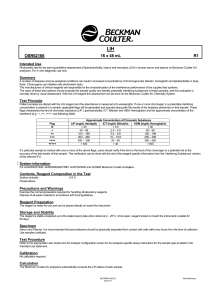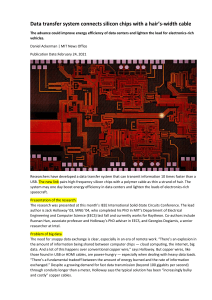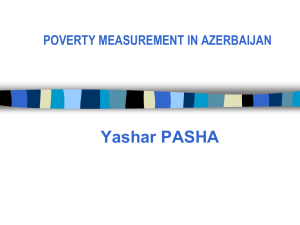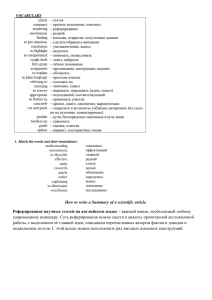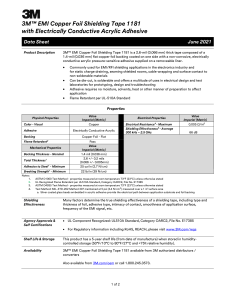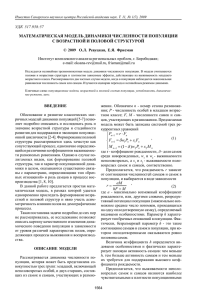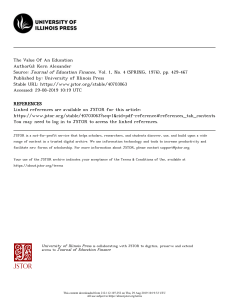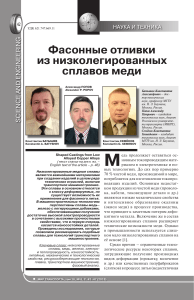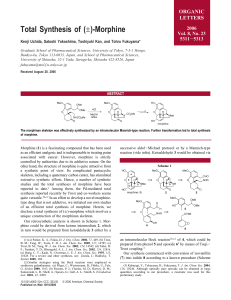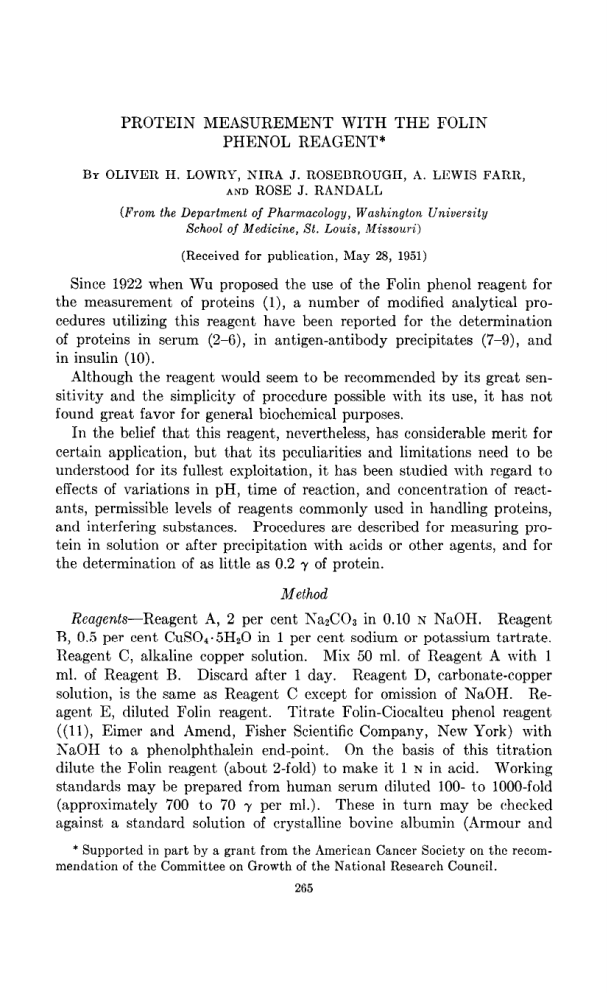
PROTEIN BY OLIVER MEASUREMENT WITH PHENOL REAGENT* H. LOWRY, AND (From the Department School THE NIRA J. ROSEBROUGH, ROSE J. RANDALL of Pharmacology, oj Medicine, St. Louis, (Received for publication, FOLIN A. LEWIS Washington Missouri) FARR, University May 28, 1951) Since 1922 when Wu proposed the use of the Folin phenol reagent for the measurement of proteins (l), a number of modified analytical procedures ut.ilizing this reagent have been reported for the determination of proteins in serum (2-G), in antigen-antibody precipitates (7-9), and in insulin (10). Although the reagent would seemto be recommended by its great sensitivity and the simplicity of procedure possible with its use, it has not found great favor for general biochemical purposes. In the belief that this reagent, nevertheless, has considerable merit for certain application, but that its peculiarities and limitations need to be understood for its fullest exploitation, it has been studied with regard t.o effects of variations in pH, time of reaction, and concentration of reactants, permissible levels of reagents commonly used in handling proteins, and interfering subst.ances. Procedures are described for measuring protein in solution or after precipitation wit,h acids or other agents, and for the determination of as little as 0.2 y of protein. Method Reagents-Reagent A, 2 per cent N&OX in 0.10 N NaOH. Reagent B, 0.5 per cent CuS04.5Hz0 in 1 per cent sodium or potassium tartrabe. Reagent C, alkaline copper solution. Mix 50 ml. of Reagent A with 1 ml. of Reagent B. Discard after 1 day. Reagent D, carbonate-copper solution, is the same as Reagent C except for omission of NaOH. Reagent E, diluted Folin reagent. Titrate Folin-Ciocalteu phenol reagent ((II), Eimer and Amend, Fisher Scientific Company, New York) with NaOH t.o a phenolphthalein end-point. On the basis of this titration dilute the Folin reagent (about 2-fold) to make it 1 N in acid. Working standards may be prepared from human serum diluted IOO- to lOOO-fold (approximately 700 to 70 y per ml.). These in turn may be checked against a standard solution of crystalline bovine albumin (Armour and * Supported in part by a grant from the American Cancer Society on the recommendation of the Committee on Growth of the National Research Council. 265 266 PROTEIN MEASUREMENT WITH FOLIN REAGENT Company, Chicago); 1 y is the equivalent of 0.97 y of serum protein (see Dilute solutions of bovine albumin have not proved satisfactory below). for working standards because of a marked tendency to undergo surface denaturation. Procedure for Proteins in Solution or Readily Soluble in Dilute Alkali(Directions are given for a final volume of 1.1 to 1.3 ml., but any multiple or fraction of the volumes given may be employed as desired’.) To a sample of 5 to 100 y of protein in 0.2 ml. or less in a 3 to 10 ml. test-tube, 1 ml. of Reagent C is added. Mix well and allow to stand for 10 minutes or longer at room temperature. 0.10 ml. of Reagent E is After added very rapidly and mixed within a second or t,wo (see below). 30 minutes or longer, the sample is read in a calorimeter or spectrophotometer. For the range 5 to 25 y of protein per ml. of final volume, it is desirable to make readings at or near X = 750 rnp, the absorption peak. For stronger solutions, the readings may be kept in a workable range by reading near X = 500 m/l (Fig. 2). Calculate from a standard curve, and, if necessary, make appropriate correction for differences between the color value of the working standard and the particular proteins being measured (see below). It is unnecessary to bring all the samples and standards to the same volume before the addition of the alkaline copper reagent, provided corThe critical volrections are made for small differences in final volume. umes are those of the alkaline copper and Folin reagents. If the protein is present in an already very dilute solution (less than 25 y per ml.), 0.5 ml. may be mixed with 0.5 ml. of an exactly double strength Reagent C and otherwise treated as above. Insoluble Proteins, etc.-Many protein precipitates, e.g. tungstate preHowever, cipitates, will dissolve readily in the alkaline copper reagent. after proteins have been precipitated with trichloroacetic or perchloric acid, for example, they will dissolve rather poorly in the 0.1 N alkali of this reagent. They become even harder to dissolve if subsequently extract.ed with fat solvents, and still more so if dried at 100’. It is not possible to cover all cases, but the following may be helpful in If the amount of protein is measuring the protein of acid precipitates. not great, so that it is spread rather thinly, it will usually dissolve in 3 Therefore, one may add, hour or so in 1 N NaOH at room temperature. for example, 0.1 ml. of 1 N NaOH to 5 to 100 y of precipitated protein. 1 For example, with the Klett calorimeter, transfer 25 to 500 y of protein in not over 1 ml. volume to a calorimeter tube. Add water if necessary to make 1 ml. Add 5 ml. of Reagent C, and, after 10 minutes, 0.5 ml. of Reagent E. Readings are taken after 30 minutes with the No. 66 filter. If the readings are too high, substitute the No. 54 filter for sample, standards, and blanks. LOWRY, ROSEBROUGH, FARR, AND RANDALL 267 After + hour or more, 1 ml. of Reagent D (no NaOH) is added, followed after 10 minutes by 0.1 ml. of diluted Folin Reagent E as usual. With larger samples, or very stubborn precipitates, it may be necessary to heat for 10 minutes or more at 100” in 1 N alkali. Although this may lower the readings, they will be reproducible and can be measured with similarly treated standards.2 Microanalysis-With a Beckman spectrophotometer adapted to 0.05 ml. volume (12), as little as 0.2 y of protein may be measured with reasonable precision. Aside from reducing the volumes of sample and reagents, the only necessary change is to use sufficiently slender tubes for the reaction. If the tubes are too large in diameter, low values will result. The following is illustrative of a procedure in which it is desired to precipitate the protein in order, for example, to measure an acid-soluble constituent of the same specimen. In this example, it is assumed that the sample volume is negligible. Otherwise a smaller volume of more concentrated trichloroacetic acid would be used. To the sample containing 0.2 to 3 y of protein in a tube of 3 mm. inner diameter and 4 cm. long,s are added 10 ~1. of 5 per cent trichloroacetic acid.4 After being mixed and centrifuged, 8 ~1. of the supernatant fluid are removed. To the precipitate are added 5 p-11.of 8 N NaOH. The sample is thoroughly mixed by tapping or “buzzing,“s and is covered e Bovine serum albumin is especially difficult to redissolve after precipitation. Several 40 mg. samples were precipitated with trichloroacetic acid, washed with alcohol and isopropyl ether, and dried. These samples dissolved very slowly in 2 ml. of 1 N NaOH. However, after standing overnight, the protein appeared to be nearly all dissolved and aliquots gave readings 97 per cent of those obtained with non-precipitated samples. Other samples were heated for 30 minutes at 100” in 1 N NaOH. These samples dissolved and the solution turned slightly yellow. The final readings checked well but were only 82 per cent of those obtained with nonprecipitated samples. Possibly, heating at lower temperature with the 1 N NaOH would have sufficed, although heating with weaker alkali would not have been effective, judging from other experience. The use of stronger alkali than 1 N did not appear to be an improvement. 8 These tubes are cleaned by rinsing with dilute NaOH, boiling in half concentrated HNOa, and rinsing several times in redistilled water. Filling or emptying of a beaker full of tubes (tall form of beaker without lip) is accomplished by slow centrifugation for a few seconds. For emptying, the tubes are transferred upside down to a second beaker with a false bottom of stainless steel screen. With the slow centrifugation required beakers will not be broken. 4 Suitable micro pipettes are the Lang-Levy variety (13, 14). For entering these narrow tubes the bent tip must be especially short and slender. 5 The tube is held at an angle against a rapidly rotating flattened rod or nail. Any high speed hand tool mounted in a clamp is satisfactory. The contents of the tube will mix violently without spilling (15). A similar effect may be had with a commercial rubber-tipped massage vibrator. 268 PROTEIN MEASUREMENT WITH FOLIK REAGEST with a rubber cap or Parafilm. After 30 minutes, 50 ~1. of Reagent D are added and the sample is mixed by “buzzing.” After 10 minutes or more, 5 ~1. of diluted Folin Reagent E are added with immediate “buzzing,” and the samples are read after 30 minutes. Standards are perhaps best prepared by precipitating 5 ~1. of 5, 10, 20, etc., mg. per cent solutions of serum protein with 5 ~1. of 10 per cent trichloroacetic acid, with subsequent treatment as for the other samples. EXPERIMENTAL There are two distinct steps which lead to the final color with protein: (a) reaction with copper in alkali, and (b) reduction of the phosphomolybdic-phosphotungstic reagent by the copper-treated protein. Reaction. wifh Copper in Alkaline Solution-The salient features of this react.ion follow. (1) The color obtained in the absence of copper is probably attributable entirely to the tyrosine and tryptophan content (16, 17), and this is not greatly increased by alkaline pretreatment ((4-6) and Table I). (2) In the presence of copper, alkaline treatment of proteins results in a 3- to 15-fold increase in color, but, in contrast, the presence of copper has only a small effect on the color obtained with free tyrosine and tryptophan (Herriott (17, 18) and Table I). (3) The reaction with copper, although not instantaneous, is nearly complete in 5 or 10 minutes at room temperature under the prescribed conditions. Heating to 100” or increasing the concentration of alkali accelerates the reaction with copper without changing the final color. (4) P re t rea t ment with alkali alone does not alter the subsequent reaction with copper in alkaline solution. Even pretreatment for an hour at 60” with 2 N NaOH, or for 5 minutes at 100’ with 1 N NaOH, when followed by the usual copper t.reatment, has almost no effect on subsequent color. Prolonged heating with strong alkali will, however, decrease the final color.2 Although the alkaline copper reaction and the biuret reaction appear to be related, they are not strictly proportional, nor, with different proteins, is the amount of biuret color directly proportional to the increment caused by copper in the color with the Folin reagent (Table I). A very small amount of copper is sufhcient to give nearly maximum final color (Table II). The action does not appear to be catalytic. Assuming the simple relationship copper + protein ti copper-protein obtains, the data with low copper concentrations may be utilized to calculate an apparent dissociation constant of 3 X 1OV mole per liter with a maximum of 1 mole of chromogenic protein-bound copper per 7 or 8 amino acid residues (Table II). Mehl, Pacovska, and Winder (19) conclude with Rising and Yang (20) that in the biuret reaction approximately 1 atom of copper is bound for LOWRY, ROSEBROUGB, FARR, .4ND 269 RANDALL I TABLE of Proteins Variously Treated The equivalent extinction coefficient z;~, (or 550) is defined as the optical density at X = 750 (or 550) rnr with 1 atom of N per liter. Nitrogen was measured by the Kjeldahl procedure of Miller and Houghton (24). The biurct color was developed with the reagents of Weichselbaum (25). Source of proteins, crystalline trypsin, crystalline chymotrypsin, and crystalline bovine albumin, Armour and Company, Chicago; cytochrome c, Sigma Chemical Company, St. Louis; crystalline zinc insulin, Eli Lilly and Company, Indianapolis; gelatin, Difco Laboratories, Inc., Detroit; L-tyrosine, Eastman Kodalr Company, Rochester. N I Extinction Coejicients Copper Protein absent Alkalinet copper treatment .L No pretreatment Alkali* reatment Trypsin................... 733 Insulin. 989 Chymotrypsin. 278 Cytochrome c. . 703 Human serum.. . 329 Bovine serum albumin. . 312 Gelatin. . 79 Tyrosine. . . . .I 13,700 I 1 In;i&hm;“ut color .- 910 998 425 738 365 358 78 13,850 I- !- 3,600 3,000 2,930 2,495 2,120 2,050 1,145 15,100 2690 - 2002 2505 1757 1755 1692 1067 1250 * 30 minutes in 0.1 N NaOH at room temperature before addition reagent. t Regular treatment as described under the procedure. $ Not valid because of the color of the cytochrome c. TABLE Biuret 26.3 24.4 25.8 1 21.4 21.8 18.0 of Folin II Color Increments from Small Amounts of Copper copper Serum protein concentration, 12.1 y per ml. K and chromogenic-bound (Cu-protein) calculated from K = Cu X protein/Cu-protein = (Cu(tota1 protein D. (assuming Cu-protein))/Cu-protein = (Cu(maximum AO. D. * - ~0. D.))/AO. that chromogenic copper bound to protein is proportioned to AO. D.). Total lo-’ Cu 0. D: at 750 nut AO. D. Ao. D., per cent of maximum A K x IO-’ Y 0 8 20 40 2000 Cu-proteint (calculated) / 78 166 237 267 286 * Optical density. t Moles per 117 gm. of protein, 88 159 189 208 42 76 91 loo 2.9 3.0 2.8 I i.e. per amino acid residue. 0.05 0.10 0.12 0.13 270 PROTEIN MEASUREMENT WITH FOLIN REAGENT each 4 amino acid residues, and Mehl et al. calculated dissociation conaveraging 10 stants for the reaction copper + protein * copper-protein times larger than the one reported herein for the formation of Folin-reacThus, of the total possible sites for copper combination, tive material. it would appear that only about half produce significant reduction of the Folin reagent, and that furthermore this fraction has a considerably greater affinity for copper than the rest. 0 20 80 40 00 120 &&s FIN. 1. “Persistence of reactivity” was measured by adding Folin reagent to protein-free alkali; after the given times, copper-treated protein was added in a small volume, and the color at 750 rnjr was measured 30 minutes later. “Color derefers to a sample of serum protein treated in the regular manner. velopment” The points on “optical density 448 mp” are observed (no protein present); the curve is theoretical for a monomolecular reaction with a half time of 8 seconds. Reduction of Folin Reagent-Three main points may be made as follows: (1) When the Folin reagent is added to the copper-treated protein, maximum color results if the reduction occurs at about pH 10. (2) At this pH the reagent is only reactive for a short time (16). It is for this reason that even a few secondsdelay in complete mixing will lessenthe amount of color (Fig. 1). The decreasein reactivity of the reagent appears to be a function of the disappearance of the original yellow color of the phosphomolybdate (half time of 8 seconds (Fig. 1)) and is presumably due to dissociation of the phosphate from the molybdate. Surprisingly, the color with protein continues to develop for a number of minutes after the reagent itself has become unreactive to freshly added protein (Fig. 1). Possibly the primary reduction product rearranges, since the absorption spectrum changes in shape between 3 minutes and 30 minutes (Fig. 2). (3) LOWRY, ROSEBROUGH, FARR, AND 271 RANDALL During the 1st minute or so after the addition of the Folin reagent, extra acid is liberated (Fig. l), which also may result from the dissociation of the phosphomolybdate. Thergfore, for maximum color, the solution must I 400 I 500 1 I 600 700 I I I 800 900 1000 mp 2. Absorption spectra 3 and 30 minutes to a solution containing 23.3 ‘y of serum protein FIG. 0 I .05 I 10 after the per ml. a .15 addition I .20 of Folin reagent .25 NaOH NORMALITY FIG. 3. Effect of alkali concentration on final color development. NaOH conExcentration is calculated before addition of 0.1 volume of diluted Folin reagent. cept as noted, final concentration of Folin reagent 3 per cent and Na&03 1.6 per cent. All samples (copper-treated protein) were identical in composition until a Final protein concenfew seconds before addition of Folin reagent (see the text). tration 12 y per ml. be rather well buffered. It was found that a mixture of NaOH, sufficient to neutralize the excessphosphoric acid, and Na&03, to buffer the mixture near pH 10, gives more color than any amount of either reagent alone (Fig. 3). Extinction Coeficients and Proportionality-Different pure proteins give 272 PROTEIN MEASUREMENT WITH FOLIN REAGENT different extinction coefficients with the Folin reagent (Table I). The extremes were observed with trypsin and gelatin which differed by a factor of 3 in chromogenicity. It will be seen that without copper much greater differences occur. The variation in chromogenicity must be kept in mind, but it is much less marked with mixtures of proteins as found in various tissues (Table III), and for many purposes is not a serious drawback. The relation of color to protein concentration is not quite linear (Table IV). TABLE Apparent Protein Content of Whole from Kjeldahl III Tissues (Rabbit) and Tissue N and from Folin Color Extracts Calculated The tissues were homogenized and precipitated with 5 per cent trichloroacetic acid (TCA), and the lipides removed by successive extraction with 0.1 N potassium acetate in ethanol, ethanol, and isopropyl ether. (The purpose of the acetate is to neutralize the acid and prevent solution of some protein in the ethanol.) The N was determined as in Table I. The extinction coefficients were calculated from the N and color of the extracted precipitates. - T Material Ektracted PPt. analyzed -Brain Kidney Liver Skeletal muscle Heart * See Table I. t By summation; Based “ “ “ “ “ ‘I “ “ “ on “ “ “ “ “ “ “ “ “ N X Folin N X Folin N X Folin N X Folin N X Folin other values are 6.25 color 6.25 color 6.25 color 6.25 color 6.25 color direct TCA extract Lipide C rtracted per cenl per cent 9.5 9.5 13.9 13.9 17.1 17.1 17.8 17.8 13.0 13.0 1.08 0.15 1be* 1.05 0.28 cent 0.30 0.21 0.49 0.28 0.15 0.09 0.20 0.17 - Whole tissue ic, cent 11.8 9.8 15.9 14.5 19.9 18.0 20.1 18.8 15.3 13.41 1960 1865 1875 1942 1975 determinations. Specificity and Interfering Substances-Few substances encountered in biological work cause serious interference. Only a little color was obtained with either acid extracts or the lipides extracted from five different tissues (Table III). Consequently measurements on non-extracted whole tissue would be in error by only 3 t,o 6 per cent, whereas values based on N determination would be overestimated by 15 to 20 per cent. Uric acid (16), guanine, and xanthine (21, 22) react with the Folin reagent. Guanine gives about 50 per cent more color than serum protein, weight for weight. The color is not enhanced by copper. Curiously, guanosine does not react appreciably. Hypoxanthine gives no color if purified (21). No more than a trace of color was obtained with adenine, ade- LOWRY, ROSEBROUGII, FARR, AND 273 RANDALL nosine, cytosine, cytidine, uracil, thymine, or thymidine (see also Funk and Macallum (22)). Neither color nor interference with protein color development was observed with the following substances at the given &al concentrations: urea (0.5 per cent), guanidine (0.5 per cent), sodium tungstate (0.5 per cent), sodium sulfate (1 per cent), sodium nitrate (1 per cent), perchloric acid (0.5 per cent neutralized), trichloroacetic acid (0.5 per cent neutralized), ethyl alcohol (5 per cent), ether (5 per cent), acetone (0.5 per cent), zinc sulfate (0.1 per cent), barium hydroxide (0.1 per cent). Most phenols, except nitrophenols, reduce the reagent (16) ; t,herefore thymol and to a lesser degree sulfosalicylic acid interfere, whereas picric TABLE Measurement Finn1 volume Optical* density at 750 mp 0.038 0.044 0.040 0.089 0.095 0.091 0.184 0.191 0.191 * Corrected 0.082 j$% 1 cm. at 750 mp 221 236 226 228 236 236 for IV oj Small Amounts of Protein from Rabbit Brain ml. Protein ~Found - ptical’ densit: at 150 Ill/I Present Y Y 0.13 0.15 0.14 0.33 0.35 0.34 0.65 0.67 0.67 0.16 0.16 0.16 0.33 0.33 0.33 0.66 0.66 0.66 0.280 0.292 0.283 0.365 0.367 0.365 0.441 0.443 0.444 Y El% 1 cm. at 750 m&t Protein Found Present Y Y 229 0.98 236 233 227 228 227 219 220 221 1.03 0.99 1.30 1.31 1.32 1.60 1.62 1.61 1.00 1.00 1.00 1.32 1.32 1.32 1.66 1.66 1.66 blank. acid up to 0.1 per cent is permissible. Glycine (0.5 per cent) decreases the color with protein by 50 per cent. Hydrazine over 0.5 mg. per cent increases the blank. Ammonium sulfate greater than 0.15 per cent final concentration decreasescolor development. This is partly due to a decrease in alkalinity, and up to 0.25 per cent or so can be tolerated if an equivalent amount of extra alkali is added to the sample. Extra copper does not seem to help. Microanalysis-With final volumes less than 0.1 ml., the amount of color is proportionately less than on the macro scale, especially if the reaction is carried out in wide tubes. Extensive testing did not definitely identify the cause of the decreased color. Neither oxygen, carbon dioxide, nor glass surface seemed to be involved. The critical step is the period of standing with alkali and copper. 274 PROTEIN MEASUREMENT WITH FOLIN REAGENT The practical solution to this interesting difficulty seems to be to use slender tubes and to run standards under the same conditions. Table IV illustrates the reproducibility of protein measurements on small brain samples. Rabbit brain was homogenized and diluted ZOO- to ZOOO-fold. Aliquots of 3.6 ~1. were analyzed for protein at a final volume of 0.082 ml. The amount of protein present was calculated from macro analyses. It is seen that the error is usually not over 0.02 y. DISCUSSION The measurement of protein with copper and the Folin reagent has certain advantages. (1) It is as sensitive as with Nessler’s reagent, yet requires no digestion. (2) It is 10 or 20 times more sensitive than measurement of the ultraviolet absorption at X = 280 rnp and is much more specific and much less liable to disturbance by turbidities. (3) It is several fold more sensitive than the ninhydrin reaction (23) and is somewhat simpler, as well as much easier to adapt for small scale analyses. Free amino acids give much more color than proteins with the ninhydrin reaction, whereas the reverse is true with the Folin reagent. (4) It is 100 times more sensitive than the biuret reaction. There are two major disadvantages of the Folin reaction. (a) The amount of color varies with different proteins. In this regard it is less constant than the biuret reaction, but more constant than the absorption at X = 280 rnp. (b) The color is not strictly proportional to concentration. From a consideration of the advantages and disadvantages, the reasonable applications of the copper-Folin reaction would seem to include (1) measurement of protein during enzyme fractionations, etc., (2) measurement of mixed tissue proteins, particularly when absolute values are not needed, (3) measurement of very small absolute amounts of protein, or highly diluted protein (e.g. spinal fluid) or protein mixed with colored substances or other nitrogen-containing substances, and (4) analyses of large numbers of similar protein samples, such as antigen-antibody precipitates. SUMMARY 1. A study is presented of the measurement of proteins with the Folin phenol reagent after alkaline copper treatment. The basic reactions have certain peculiarities which need to be taken into consideration in using this reagent. 2. Directions are given for measurement of proteins in solution and proteins which have been precipitated with acid, etc. A micro procedure is also described for the measurement of as little as 0.2 y of protein. 3. The differences in the amount of color obtained with a number of proteins is recorded. Interfering substances are listed. LOWRY, ROSEBROUGH, FARR, AND 4. The advantages of simplicity and sensitivity mend it for a number of biochemical purposes. RANDALL 275 of this reaction recom- BIBLIOGRAPHY 1. 2. 3. 4. 5. 6. 7. 8. 9. 10. 11. 12. 13. 14. 15. 16. 17. 18. 19. 20. 21. 22. 23. 24. 25. Wu, H., J. Biol. Chem., 61, 33 (1922). Wu, H., and Ling, S. M., Chinese J. Physiol., 1, 161 (1927). Greenberg, D. M., J. Biol. Chem., 82, 545 (1929). Andersch, M., and Gibson, R. B., J. Lab. and Clin. Med., 18, 816 (1933). Greenberg, D. M., and Mirolubova, T. N., J. Lab. and Clin. Med., 21,431 (1936). Minot, A. S., and Keller, M., J. Lab. and Clin. Med., 21, 743 (1936). Pressman, D., Ind. and Eng. Chem., Anal. Ed., 16, 357 (1943). Heidelberger, M., and MacPherson, C. F. C., Science, 97, 405 (1943). Kabat, E. A., and Mayer, M. M., Experimental immunochemistry, Springfield, 321 (1948). Sutherland, E. W., Cori, C. F., Haynes, R., and Olsen, N. S., J. Biol. Chem., 180, 825 (1949). Folin, O., and Ciocalteu, V., J. Biol. Chem., 78, 627 (1927). Lowry, 0. H., and Bessey, 0. A., J. Biol. Chem., 183, 633 (1946). Levy, M., Compt.-rend. trav. Lab. Carlsberg, SBrie chim., 21, 101 (1945). Bessey, 0. A., Lowry, 0. H., and Brock, M. J., J. Biol. Chem., 184, 321 (1946). Bessey, 0. A., Lowry, 0. H., Brock, M. J., and Lopez, J. A., J. Biol. Chem., 188, 177 (1946). F&n, O., and Denis, W., J. Biol. Chem., 12, 239 (1912). Herriott, R. M., J. Gen. Physiol., 19, 283 (1935). Herriott, R. M., Proc. Sot. Ezp. Biol. and Med., 48,642 (1941). Mehl, J. W., Pacovska, E., and Winzler, R. J., J. Biol. Chem., 177, 13 (1949). Rising, M. M., and Yang, P. S., J. Biol. Chem., 99, 755 (1932-33). Hitchings, G. I-I., J. BioZ. Chem., 189, 843 (1941). Funk, C., and Macallum, A. B., Biochem. J., 7, 356 (1913). Kunkel, H. G., and Ward, S. M., J. Biol. Chem., 182, 597 (1950). Miller, L., and Houghton, J. A., J. Biol. Chem., 169, 373 (1945). Weichselbaum, T. E., Am. J. Clin. Path., 16, Tech. Sect., 10, 40 (1946).
